Table of Contents
Faced with a complex marketing environment and increased ROI pressure, B2B email marketers must satisfy many sales targets.
Due to the lengthier purchase cycles that B2B enterprises often encounter, your marketing plan will involve extra nurturing activities to sustain contact between your brand and prospects.
To handle complicated buyer ecosystems, many B2B marketers have resorted to email marketing automation services. Consider sending a separate email to each email contact each week; you know this is not feasible as a busy marketer.
Email marketing automation enables you to create integrated programs sent at the optimal moment and provide value for your leads. Automation also can save your brand important resources and cash with the proper setup and plan.
Is it a wise investment for your company to invest in email marketing automation? First, let’s examine what email marketing automation is and how you may use it in your B2B organization.
What is Email Marketing Automation?
Marketers use email marketing automation software to send emails to prospects and customers automatically. You create email workflows based on rules and triggers that send separate emails based on the subscriber’s behavior or stage in the sales funnel.
For instance, when someone subscribes to your brand updates, they are instantly enrolled in your workflow, which sends them notifications about forthcoming events and recaps. Similarly, when a visitor completes a contact form on your website, your automated marketing software will send a confirmation email with a thank you message.
These leads will be immediately loaded into your Customer Relationship Management System (CRM) or other contact management system. Additionally, automation software will track how each lead engaged with your website, providing you with additional information into their interests and probable demographics.
How Does It Work for B2B Email Marketing?
Personalizing messages and sending the relevant emails to the appropriate recipients is critical for increasing the number of times your emails are viewed and clicked. These time-consuming chores are simplified by email automation software, which aids in B2B email marketing by sending customized messages and nurturing prospects throughout the purchase cycle.
When someone provides information to a firm, it is recorded into your Customer Relationship Management (CRM) system or contact database, storing all your lead data. You may segment your leads using the program depending on their activity and your lead intelligence. This makes it simple to customize your emails and consistently increase the connection between company and customer.
The marketing automation system will track where and how each contact interacts with your website, revealing their interests and demographic information. You may then communicate with those visitors depending on the sites they visited, the articles they read, and the activities they took on your site.
Automation of B2B email marketing may help with lead creation and nurturing. However, it has the potential to raise sales income and consumer engagement. Surprisingly, not everyone is automating their processes. In 2015, over 60% of marketers used email blasts to communicate with clients, while just 13% used automation tools.
Benefits of B2B Email Marketing Automation
B2B marketers use this software to automate more time-consuming processes that demand more personnel on a larger scale. Marketing automation is at the heart of every inbound marketing plan since it enables you to maximize the effectiveness of your current resources.
Regardless of the size or capabilities of your firm, email marketing automation gives the following benefits:
Enhances marketing effectiveness
Email automation helps you save time and money. For example, your salesmen may enhance their response rate and appointment setting, while your marketing staff can concentrate on more strategic initiatives than administrative tasks.
Email automation enables you to eliminate time-consuming procedures such as the following:
- Creating useful content
- Segmenting audiences depending on their behavior
- Nurturing leads to reducing the length of the sales cycle
- Planning and executing campaigns in advance
- Elimination of redundant or contradictory data and leads
- Enhancing internal and external team communication
Rather than wasting time on tiresome tasks, you may increase your total productivity. Email marketing automation enables you to manage all of your channels from one platform rather than to need separate tools for each channel.
Qualifies and converts leads
As a B2B marketer, your primary objective is to provide value to prospects and existing clients. This may be accomplished by automating your processes: in fact, 69 percent of top-performing B2B organizations utilize marketing automation for client acquisition and 50 percent for customer retention.
Why? Instant, timely interactions enable you to establish business connections and convert leads without manually doing everything.
Email automation software integrates behavioral data—links clicked, emails read, and transactions made—with lead scoring, providing you with a complete picture of your sales funnel.
For instance, you may use lead magnets on your website to ascertain your leads’ preferences and then send them appropriate material based on those interests. Valuable content can shorten the purchase cycle and convert leads into clients.
Increases ROI
B2B marketers that automate their email marketing have the potential to grow their sales funnel. Why is marketing automation so effective at revenue generation?
Lead cycle customization may be used in conjunction with software to connect with the appropriate subscriber’s section at the proper time. By engaging in one-on-one conversations with leads, you can more effectively express your value and encourage subscribers to make a purchase.
Additionally, email automation does not strain your budget or use excessive amounts of internal resources. As a result, you may do less while yet having a more significant influence on your brand.
Consistently aligns sales and marketing objectives.
While marketers and sales staff have a reputation for clashing, email automation facilitates communication and collaboration between these two departments.
Email automation generates a more significant number of quality prospects for the sales team to pursue and nurture. Rather than spending time assessing prospects, your emails inform your sales team whether leads are ready for the final sales presentation or need additional time. After all, cultivated leads generate 47 percent more revenue.
Your marketing and sales teams may collaborate to create a more simplified plan by collaborating and establishing guidelines. As a result, you may influence the whole sales cycle—marketing demonstrates the first interaction with prospects, while sales concentrate on ultimate conversions. It’s an ideal team for your brand, one that will pay you in the long run.
Techniques for Building a B2B Email List
One of the most challenging tasks facing B2B marketers is attracting quality visitors to their website and turning leads into customers.
The most effective method of converting leads to paying clients is to develop an email list and maintain touch with them. However, how can you amass a sizable B2B email list?
Provide a no-cost consultation
Offering free consultations is an efficient strategy for growing a qualified B2B email list.
Your website visitors will have the opportunity of meeting and get to know the people behind the company through consultation calls.
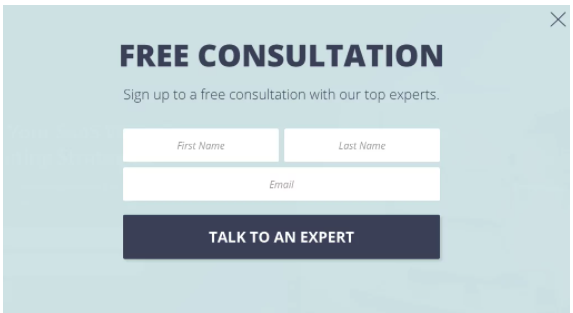
This strategy enables you to infuse your lead generating process with a human element, and you may utilize such calls to:
- Acquaint yourself with your prospects
- Establish credibility and authority
- Share successful case studies with us.
- Cross-sell or upsell your business-to-business (B2B) products/services
Free consultations are advantageous for selling high-ticket items since a client conversion is worth the time and resources spent on the consultation.
Alternatively, free consultations let you learn more about your consumers while you’re just getting started if you’re a consulting firm.
And may adapt the structure to a webinar based on the trends uncovered throughout the discussions.
Organize a webinar on an educational subject
Hosting a webinar is one of the most effective strategies for growing your B2B email list.
This strategy enables you to deliver valuable material to your prospects and customers to assist them in better understanding their market, staying current, and learning more about your organization.
According to research conducted by Convince & Convert, 67% of B2B marketers get leads using webinars.
Promote email-only information
By marketing on your website that you provide certain information to email subscribers, you’re communicating to your prospects that you’re interested in speaking with them directly.
Additionally, it will assist deliver a more personalized experience for individuals contemplating subscribing in the first place.
Who among us does not want to be treated like a VIP?
Exclusive email content creates a sense of VIP status among your target prospects, encouraging them to subscribe for more.

Email-only content is ideal for SaaS firms looking to educate, nurture, and finally convert their prospects.
Include a free trial
If you provide a free trial, you demonstrate to prospects that they have nothing to lose by learning more about your organization.
Additionally, the time limit is ideal for people who prefer convenience to pore through facts before making judgments or committing.
A free trial enables prospects to test your solution and evaluate its value while capturing their contact information and sending them onboarding communications.
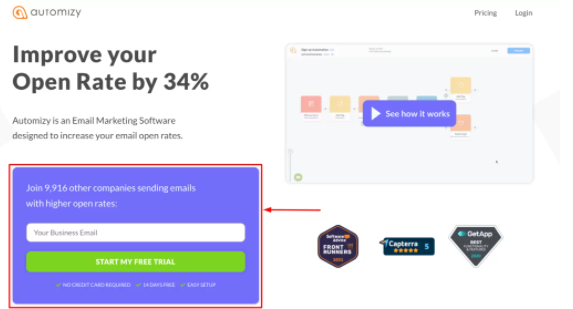
B2B customers’ purchasing patterns are shifting due to B2C applications like Netflix and Spotify, and businesses must now respond.
Indeed, according to Forrester, three out of every four Business to Business (B2B) customers would prefer to educate themselves on a product than learn about it from a sales representative.
By giving a free trial, you’re promoting a product-led approach that allows your target audience to evaluate your tool and determine its worth.
Transparency in Your Sales Techniques
If you do not maintain complete transparency with your email list members, they will feel duped and misled.
The idea is to state plainly and honestly that you are sending emails with a business purpose in mind.
By subscribing to your newsletter, you may inform them of the content they will receive.
For instance, in your confirmation emails, you might inform your contacts about the kind of information they can anticipate.
Additionally, you may share your privacy statement with them.
While your B2B emails may not include a “hard pitch,” recipients are aware that they are coming from someone with aims and interests in mind.
B2B Email Automation Campaign Ideas
Consider the following types of B2B email automation while developing your approach.
Welcome email series
A welcome email series is your first chance to establish rapport with new leads, prospects, and customers. You may distribute this series in several ways, including when someone makes a new purchase, completes a form for gated content, subscribes to your email list, attends an event, or takes another action. It’s a generic introduction to your brand.
A welcome series does not have to have a fixed duration. You may send a single email or numerous. Conduct a test to see what works best for your business. A welcome email series provides a chance to:
- Congratulate or express gratitude to someone for opting in.
- Demonstrate your values, purpose, and fundamental beliefs that guide your actions.
- By building a picture of what someone can do if they remain with you, you may arouse emotions and satisfy wants.
- Invite them to join you and underline the sense of community that your business has created.
- Provide them with a ‘fast win’ – something you provide for free that they can immediately execute and see results from.
- Demonstrate your character.
- Demonstrate your experience and authority.
- Share consumer feedback and success stories.
- Make a sales pitch or suggest an upsell.
You prioritize which email in the series is determined by several criteria unique to your organization and objectives. However, an influential welcome series will address as many of them as feasible.
They say to put your best foot forward, and that is precisely what Niice’s automated greeting series achieves. In addition, the email contains a nice welcome video and invites prospective members to learn more about the product’s features and advantages via the use of user information.
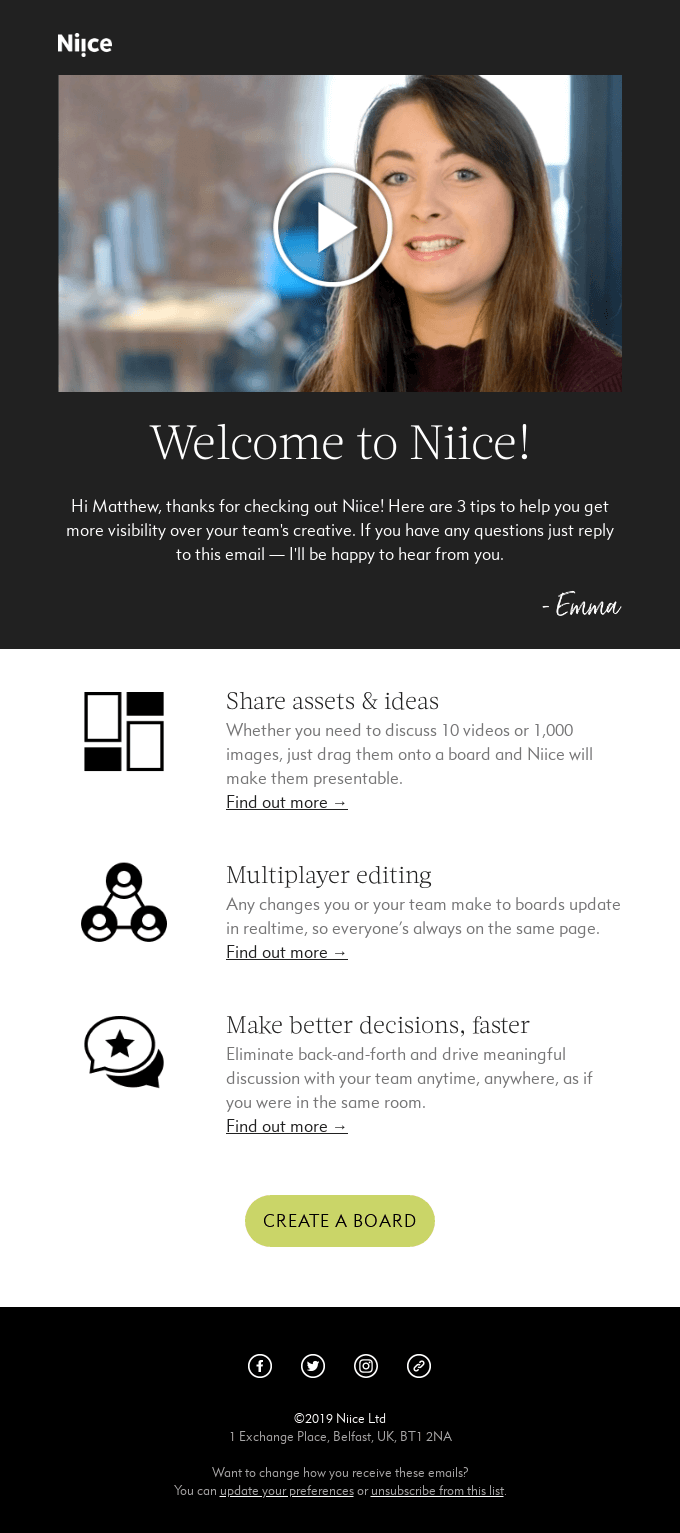
Nurture campaigns based on personas and roles
Emailing chief technology officers at businesses with 100 or more people will be considerably more successful than emailing your whole list if you’re offering software services.
Why? Because you can address their needs, interests, and problems directly. You can communicate in their language, demonstrate your understanding of their predicament, and win their trust.
This is why it is critical to separate your email list into email segments or sub-lists. While you may not know a subscriber’s title or precise job function, you may still segment them by factors like the landing page that convinced them to join your list or the lead magnet they downloaded.
Consider how NewsCred (which has now been renamed Welcome) chose the information for this email intended for C-suite executives.
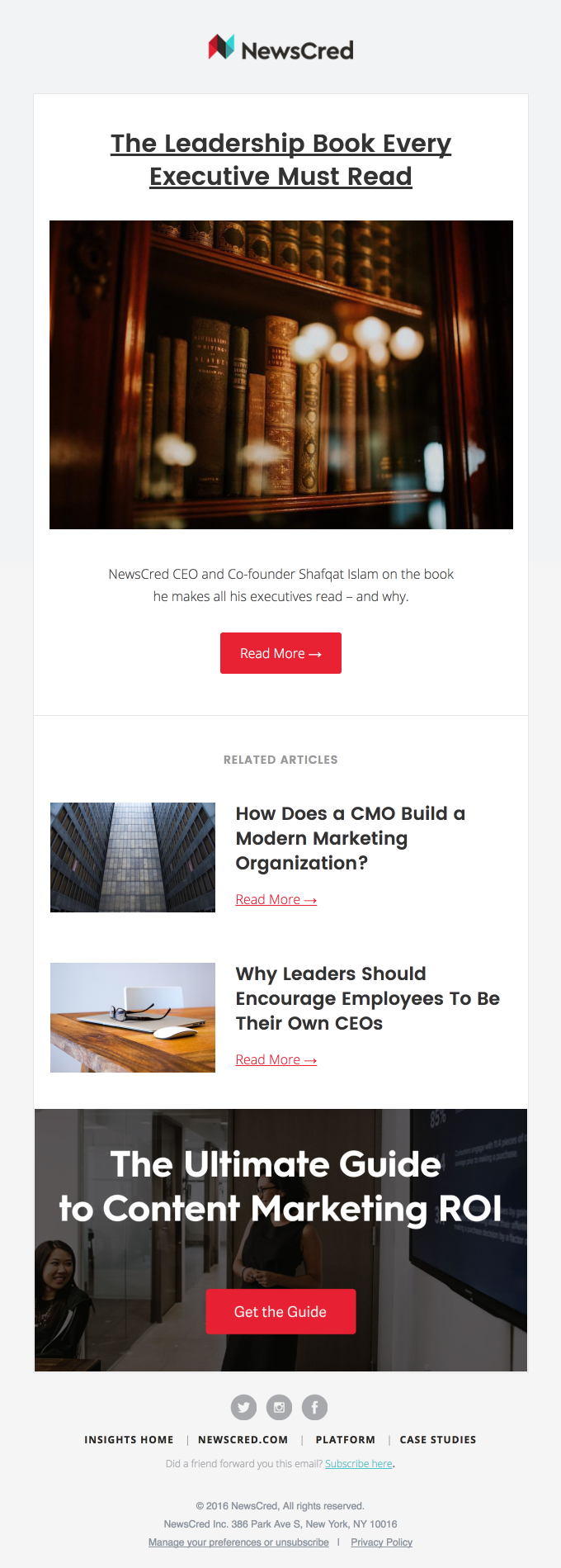
When utilized effectively, personas are practical tools. Learn how to include buyer personas into your email marketing strategy.
Nurture marketing tailored to particular content
Assume your business is involved in the fabrication of HVAC equipment. You may be selling to house builders, business establishments of all types, and government offices, as well as the HVAC installers and contractors serving those sectors. Each of these individuals has a unique set of requirements, preferences, and pain spots.
According to MarketingSherpa, irrelevant material is the second leading reason for unsubscribes. However, if you understand your readers’ interests, you can circumvent this issue long enough to add value to their day and explain how your goods or services suit their demands.
In our HVAC example, housebuilders are likely to possess the experience necessary to determine the precise kind of equipment they want. However, they may benefit from advice on enhancing installation efficiency and scaling up quality control systems. Meanwhile, HVAC installers in their communities would enjoy the information that assists them in explaining and selling various types of procedures to homes.
Thought leadership nurture series
Nowadays, a great deal of material is derived from other works. And it is an entirely acceptable tactic. However, creating fresh material helps prospects regard you as more authoritative and knowledgeable.
As part of a thought leadership series, your messaging should focus on the “why” behind industry trends, developments, or standards. It’s often more practical to position your company’s leadership as the creators of thought leadership material rather than the marketing team. You want to establish that corporate executives are forward-thinking and that their knowledge pervades the whole firm.
While original thought leadership is preferable, you may “borrow” authority by including well-known personalities into your material. For example, suppose the industry’s most recognizable leader is prepared to “sit down” with an executive at your firm. In that case, this demonstrates a vote of confidence in your ability to accomplish things appropriately.
Bear in mind that thought leadership is often about timing and relevance. You cannot be a leader if you accept and promote a concept late. As a result, these B2B email automation types must be routinely updated and linked with the client experience.
Sales follow-up emails
What happens once your product is demoed? What next to do your prospects hear? Frequently, you’re demonstrating to end-users rather than the decision-maker. Even though you collaborate with a decision-maker, they may need more analysis or consultation with other team members.
What does this imply for you? This signifies they’ve taken on the role of your primary salesman. However, are they adequately equipped?
You are responsible for ‘training’ them, which you may do with a follow-up email series. Restate yRestateantages. Demonstrate your worth. Distribute testimonials. Exhibit results. Provide data. Address frequent objections and misunderstandings. Give them the ammunition they need to sell your system to their teams.
Here’s how SalesForce handled contacts gained during a 2018 live event.
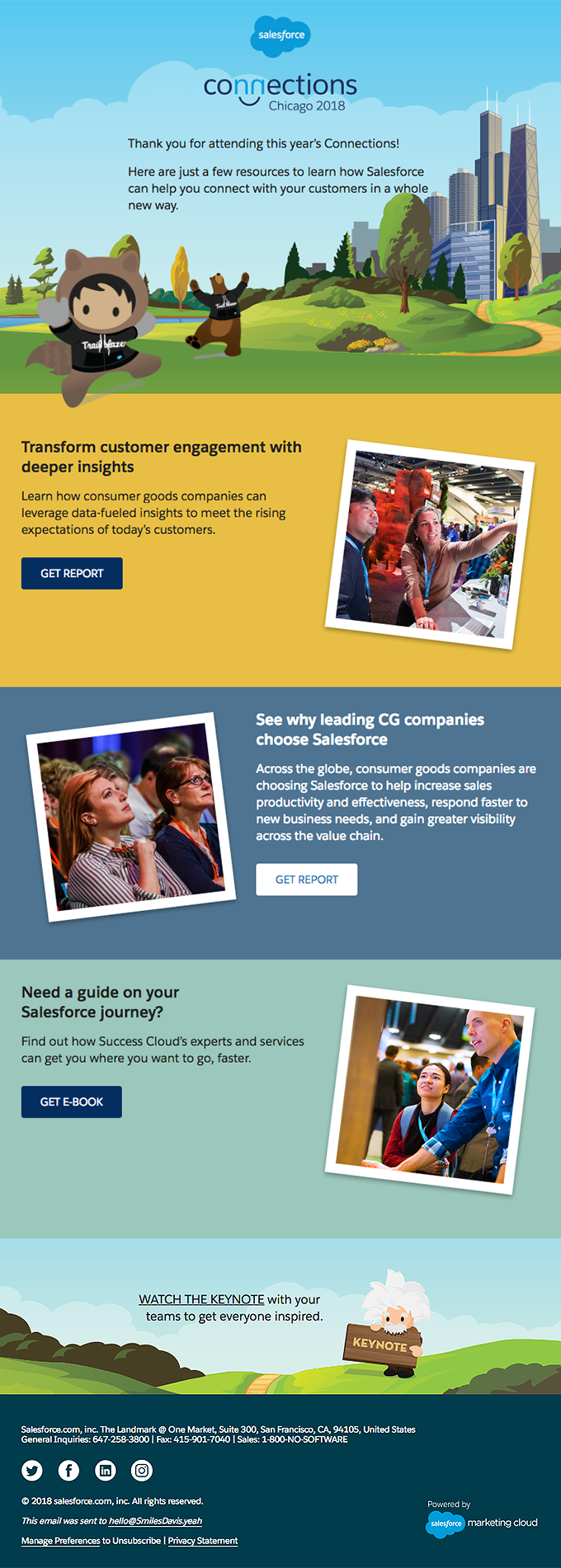
Email onboarding series
After a customer makes a purchase, you should continue to communicate with them through email. You want them to succeed to maximize the value of your goods and services. Occasionally, the successful adoption of a new product needs some training and instruction.
You may do this by creating an onboarding email series. This may involve the following:
- How to utilize your product instructions.
- What to do if anything goes wrong.
- Additional methods to use your product.
- How to extend its life, improve its performance, or repurpose it.
- Products and services that are related.
- Notifications of expiry and renewal.
- They may attend events.
- Customer testimonials that reassure them about their purchase.
- Possibilities for feedback and testimonial sharing.
The onboarding email from HubSpot maintains the enthusiasm level and encourages users to continue along the onboarding route. The message provides a checklist-style list of steps to get started on the platform, while the headlines reinforce the program’s primary selling features. Additionally, there are several opportunities for readers to investigate their favorite areas, as well as an upsell CTA at the conclusion.

Event marketing email series
You face various live and virtual events problems, which might include tradeshows, seminars, and webinars.
To begin, you’ll need attendees, including those who signed up. No-show rates may be relatively high, especially for webinars.
Second, you want them to be enthusiastic about the occasion. Third, you want them to anticipate it.
Thirdly, you must follow up. Sales are generated far more following events than during them. This is because the return on investment for events is in the follow-up.
All three of these obstacles may be overcome by launching a high-impact event marketing campaign that starts far before the event and continues long after it concludes.
You want to restate restates and make bold promises about results and incentives in this series. Then, as the event approaches, clarify the logistics: how to register, where to go, what to click, early-bird deadlines, special offers for gifts, and last-minute reminders to attend.
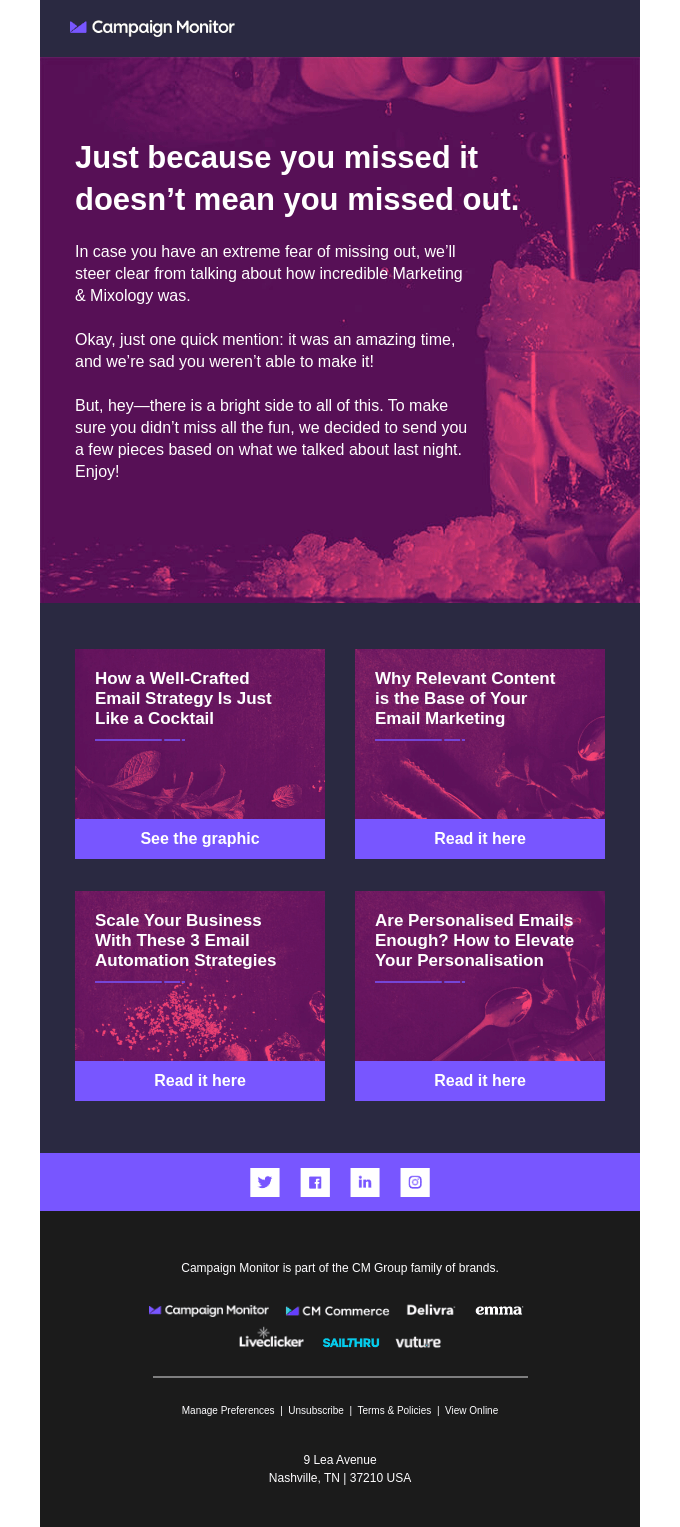
Campaign Monitor’s post-event email was created expressly for no-shows. Though not as effective as attendance, an automated email series explicitly targeted at people who missed the event may help you maximize the value of your efforts.
Launches of new products and upsells
These are plain-and-simple sales emails. However, if your subscribers are enthusiastic about your product, this is not an issue. For example, consider how excited people are about Apple’s newest release.
Utilize B2B email automation to generate excitement and collect pre-orders for product launches. Additionally, you should automate email marketing upsells, which encourage clients to upgrade to more expensive plans or goods. Emphasize the advantages of premium features and engage customers with special incentives.
Different emails should address various parts of the deal. For example, utilize testimonials to demonstrate the research that went into developing the new product, the unmet need for which it was created, the consequence it would bring for the client, why their bosses will enjoy it, and the genuine sales offer.
Designmodo offers its new product in three distinct ways that avoid redundancy. This level of customization enables members to choose their way ahead, which may boost engagement rates. They begin with a video, a textual explanation, and an (incomplete) bullet point list optimized for click-throughs. So naturally, there are several chances for readers to jump ship and purchase immediately.

Campaigns for customer feedback
How can you create more effective B2B email list segments? Distribute surveys.
You may want to collect feedback several times along the client experience. For example, what were their impressions of the onboarding process? What are their emotions 90 days, six months, or a year after signing with you? Could your business serve them better in the future?
Timing is critical. By automatically sending emails containing customer surveys in response to particular actions and time intervals, you ensure that you get the appropriate input from the right individuals.
Justify the importance of the survey and the contribution that subscribers will make by completing it. Include an incentive such as a sweepstakes entry, a unique gift, or a discount on future purchases. Additionally, survey initiatives should have a deadline. Construct your campaign around that day and include reminder emails.
Surveys are an excellent way to get insightful input on your company’s and product’s performance in various critical areas. When you can determine your clients’ most urgent concerns, you may deploy your money more precisely to achieve the most significant advantages.
Campaigns for customer retention
Once you’ve acquired a client, you want to retain them. But, unfortunately, you may lose them to rivals or to ‘nothingness’ — disinterest. They may still be on your list, but their thoughts have moved on.
The easiest way to avoid this is to please them.
Proactively design a few B2B email automation campaigns each year to promote special deals, limited-time discounts, or possibilities for exclusive access to anything, such as a sneak look at a new product or event. Making your consumers feel unique and desired — as if they were VIPs — is an excellent strategy to boost their loyalty.
Additionally, you may reinforce good thoughts by using testimonials and case studies that demonstrate the impact you’re having on your clients’ organizations.
Additionally, maintain a helpful and relevant presence by offering timely recommendations, how-to videos, and material that addresses their specific requirements.
Renewal campaigns for subscriptions
If your business is based on a subscription or membership income model, renewals are critical. How you handle subscription renewals is determined by whether they are renewed automatically or manually.
If the process is automated, a retention campaign might be more suitable. On the other hand, if the transaction is manual, such as an annual software license purchase or service usage, this email series should emphasize customers’ fundamental value. Additionally, it may contain a poll soliciting comments on how you can improve. Finally, if a customer expresses discontent with a particular aspect of the product, this may prompt an extra email regarding planned, relevant product changes.
This series should do more than just hammer them in the head with reminders that their membership will end. Of course, you will need some of that, but you will get more outcomes if you demonstrate gratitude and provide value.

Though it seems to be a regular renewal email, this one from Namecheap is hugely successful since it gives a unique, reduced offer, proposes extra and alternative purchases the user might make, and builds urgency by tying the bargains to a deadline.
Campaigns of re-engagement
Specific consumers have not purchased in a while or have been on your list but have ceased responding to your communications. If you sell a service, you may realize that the customer has stopped using it. If it’s a subscription service, you’ll need a B2B email automation campaign to ascertain if anything is incorrect and how you can continue to be relevant to their company.
Occasionally, this might be an excellent way to remind subscribers about your product while nudging them toward a superior choice. Consider how Grammarly intends to use this email to revive and reengage consumers.
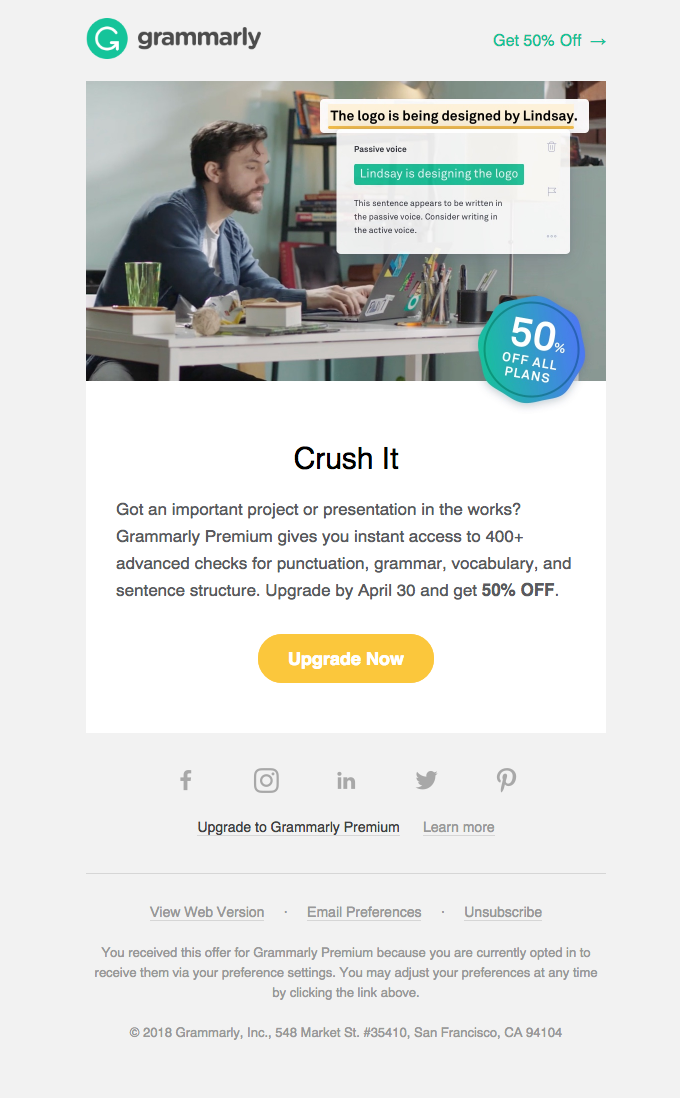
Additionally, re-engagement initiatives might contain the following:
- Surveys that elicit information on communication preferences.
- Offers made just once to re-sell customers on doing business with you.
- Exclusive consultations or ‘problem-solving sessions’ are offered.
- Simple inquiries as to if they still want to hear from you.
Series of thank you emails
B2B organizations often engage with expensive services, and selecting the correct suppliers and solutions requires a great deal of confidence. Therefore, a little act of appreciation may go a long way. Consider sending more than a single “thank you” email.
This campaign performs best on anniversaries: when a client initially becomes a subscriber or when a customer renews their membership. Your automatic thank you campaign may include awards, unique presents, invitations to exclusive events, notable movies, and images – have fun with it. Ensure that it is genuine and personal.
Consider the engaging manner in which FontShop acknowledged new subscribers for subscribing to their email newsletter. It’s more than a thank you; it increases anticipation for what’s to come, increasing the likelihood that those newsletters will be disregarded.

Final Thoughts
If you’re serious about building your lead funnel and improving conversion rates, email marketing automation may significantly help you accomplish your goals.
Modern automation technologies enable you to create targeted campaigns that address your leads’ pain points and accelerate their progress through the sales funnel.
